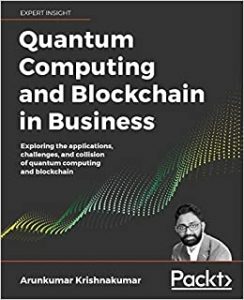
If you think, like I did twenty minutes before I began to read Quantum Computing and Blockchain in Business by Arunkumar Krishnakumar, that quantum computing is the combustion engine to Blockchain’s buggy whip, then the book may force you out of this cognitive comfort zone.
From Arun’s eminently readable book, I now understand that my initial idea of quantum and Blockchain technologies being incompatible is a very shallow read on these two incredibly deep and powerful innovations. He makes that point early and often throughout the book. To the author, these two technologies may be bound to collide, but rather than an unstoppable force (quantum computing) striking the immovable object (Blockchain), these two revolutionary technologies may actually find ways to, dare I say, work with each other. More on this later.
Members of both the quantum computing and Blockchain communities would do well to read this book.
However, even if you have no experience in either the quantum computing or Blockchain game, this book will at least serve as a clear and interesting outline of both technologies. Arun explains both these technologies in detail without getting lost in the weeds. Talking about weeds, there are no weedier plots of ground like quantum computing and Blockchain. Quantum computing (QC) is the ability to use the strange properties of quantum mechanics to compute. QC can also crack codes, such as the ones that the financial industry uses to protect accounts. Blockchain is the ability for a distributed network of computers to track transactions, without a middleman. In addition to other benefits, Blockchain offers added layers of security to protect data.

“While Blockchain is designed to safeguard so many personal and corporate transactions, will quantum’s ability to crack codes render it obsolete?”
Quantum computing and Blockchain across several industries
Summarizing the general implications of QC and Blockchain would have been easier; however, what I genuinely appreciated about this book’s approach is that the author breaks down how specific industries and businesses may be impacted.
As you can probably guess from the above information, the financial industry is one of the main targets of disruption by both Blockchain and quantum computing, so Arun spends some time outlining those implications. He adroitly points out perfect storm that is whipping up around Blockchain in the financial technological industry. While financial service companies are among the least likely to adopt new innovations, Fintech firms, which are innovative companies that use digital technology to provide financial solutions, have a tendency to, if not a nasty habit of, blindsiding these behemoths. He then explains that Blockchain is more than just a new technology, it has become a new battleground for these firms. It’s possible, then, that both Fintech and larger financial firms may end up unleashing quantum and Blockchain innovations if for no other reason than they want to beat the competition to the market with Blockchain- or quantum-backed solutions.
The book also offers explanations of the numerous areas where Blockchain will make a stand. These applications are: Anti-money-laundering (AML) and Know Your Customer (KYC), trade finance, remittance and central bank-backed currencies, to name a few.
Arun points out the essential issue: “While Blockchain is designed to safeguard so many personal and corporate transactions, will quantum’s ability to crack codes render it obsolete?”
A Quantum Safe Blockchain?
Probably the most important part of the book comes toward the end after the author sets the necessary foundation in place for the reader to explore the future of these potential technologies – or not. According to Arun, these two technologies are absolutely needed, and these are also involved in a technological steel cage match where only one may very well leave the ring.
“Therefore, we need both technologies to go mainstream to deal with the data challenges in the future. However, there is a catch. The two technologies are on a collision course.”
He writes: “Therefore, we need both technologies to go mainstream to deal with the data challenges in the future. However, there is a catch. The two technologies are on a collision course. Cryptography is an integral part of both quantum computing and Blockchain. There is a potential scenario where the Blockchain solutions we have today will be obsolete as soon as quantum computers scale and become mainstream. Therefore, despite the business case for these technologies, we may only see one of the two technologies being relevant in the future.”
But, because one person’s problem is another person’s innovation success story, there is hope. Post-Quantum Cryptography (PQC) is the essence of that hope. He writes that PQC would “need to be immune to quantum Fourier sampling as well as other classical and quantum attacks.” He offers several techniques that are being investigated today, such as Lattice-based Cryptography, Code-Based Cryptography and, of course, Blockchain Cryptography.
Some techniques that can make Blockchains more secure in the post-quantum world include eXtended Merkle Signature Scheme (XMSS), Blockchain Post-Quantum Signatures (BPQS), and Winternitz One-Time Signatures (W-OTA). The latter is used by IOTA.
These are all discussed in detail.
Expert Help
Because the science behind Blockchain and quantum computing is not just complex, but varies wildly, Arun enlists the help of experts. Few chapters contain an expert interview. The reader might think about skipping these sections and getting into the meat of the section, but I would advise you not to do this. This isn’t just filler material. They are thoughtful and carefully executed interviews that can help someone settle into the issues raised in the rest of the chapters.
The Future
I’ve really just scratched the surface in this review, however, if you’re interested in quantum computing and Blockchain, which is the future, then Quantum Computing and Blockchain in Business makes an excellent guidebook and Arunkumar Krishnakumar makes an excellent guide.
















